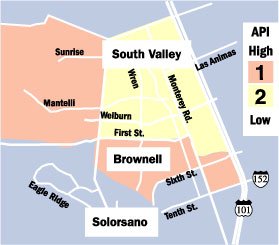GILROY
– At the very least, school attendance rates are a tell-tale
sign of how students will perform on standardized tests and in
school in general, recently released data indicates.
Based on Gilroy Unified School District attendance rates, there
is a relationship between high attendance in the highest-performing
schools and low attendance in the lowest-performing schools.
GILROY – At the very least, school attendance rates are a tell-tale sign of how students will perform on standardized tests and in school in general, recently released data indicates.
Based on Gilroy Unified School District attendance rates, there is a relationship between high attendance in the highest-performing schools and low attendance in the lowest-performing schools.
That’s not to say there aren’t exceptions. There are a myriad of factors that play in to school attendance, particularly transportation for some GUSD elementary students, or a desire to attend, for high school students. But absentee rates in GUSD seem to fall along some surprising and some not-so-surprising lines.
According to district data, students in the Luigi Aprea Elementary School attendance area went to school the most this year. The northwest-quadrant school also has the district’s highest Academic Performance Index score, 837, which is assigned by the state based on standardized test scores.
On the other hand, Gilroy High School, which includes students from all attendance areas, has the district’s lowest attendance rate this year at 92.58 percent. Its API score of 654 also is the lowest in the district.
“You can look at it from two perspectives,” said Frank Valadez, GUSD’s attendance officer. “One, if the student is not there, obviously, they’re not going to progress with the student body.
“But two, if the student is not there, is not progressing and then they’re not there to take the test, then test scores are going to go up.”
However, schools make an effort to test as many students as possible, even using make-up days to meet a federal requirement that 95 percent of all students take standardized tests.
“I think logic would tell us that if a kid misses school, then they’re going to miss out,” Valadez said. “We know that poor attendance contributes to low grades, it contributes to the dropout rates … so I’m sure that that carries over to test scores.”
Top schools have top attendance
Three out of four of the district’s top-performing schools also rank in the top four based on attendance. The reverse is true, as well: Three out of four of the district’s lower-performing schools rank in the bottom four for attendance rates. To figure average daily attendance, the total number of days of student attendance is divided by the total number of days in the regular school year. The attendance rate refers to the percent of school days that students attended.
Looking at attendance areas is not cut-and-dried, as this is only the second year that GUSD has had neighborhood schools.
“We really don’t have an ability to measure by attendance area because there are many that are going to school outside those attendance area,” Brinkman said. “Depending on the school, anywhere from 35 to 50 percent of kids are going to school outside their attendance area.”
GUSD’s attendance goals were per school this year, rather than specific attendance areas.
Trustee David McRae said the attendance-test score correlation at schools is not surprising.
“It’s pretty well understood that the kids who are in school the most and get the most support in that tend to perform the best,” he said. “I think parents that emphasize being in school, also check on homework and tend to focus on schoolwork more.”
Socio-economic issues come into play, as well, Valadez said.
“Now even more so because we’ve gone to neighborhood schools, so the school represents the neighborhood and – as is true across the nation – low-income kids, their attendance is poorer.”
Eliot Elementary School could be one example. The school, with an attendance area in southeast Gilroy, has the district’s lowest attendance rate after GHS, and its API score ranks at the bottom of eight elementary schools and is eighth out of 11 GUSD schools.
Transportation, however, probably affects Eliot attendance the most because the students are attending a school across town this year and next.
“It’s a low-income area to begin with, and now those kids are having to board the bus at the old Eliot site,” Valadez said. “So they have to be out there early, so I’m sure that doesn’t contribute to improved attendance.”
Brinkman said that, due to Principal Diane Elia’s focus on attendance, he expects Eliot’s percentage will increase significantly once the school on Seventh Street is rebuilt.
Transportation also could be a factor in Rucker’s attendance rate, which is the third worst in the district, while its API is the second best. The school, at 325 Santa Clara Ave., is in a rural area about a mile north of Gilroy city limits. Although it has GUSD’s second-highest API, attendance is third from the bottom of the list.
Las Animas, at 8450 Wren Ave., is another notable exception. The school’s attendance is at the middle of the pack – fifth out of 11 schools – while its API is the lowest in the district at 648. Based on data from the state department of education, the school has the highest number of students receiving free or reduced-price lunches, which are given to low-income students.
Luigi, with top attendance and API rankings, could be evidence of the low-income effect in reverse. The attendance area includes most of this city’s newest housing developments and home prices in the neighborhood are skyrocketing as parents try to get their children into the high-performing school.
Attendance is serious business.
School-age children and teen-agers are required by law to go to school. Parents are required to make sure their children get to school and adults who help students miss class can be prosecuted.
The state punishes, in a way, schools that have low attendance because it doles out money based on the number of students who are physically in class each day.
The federal No Child Left Behind school improvement initiative says that if fewer than 95 percent of a school’s students are in attendance to be tested, the school gets a failing grade for the year and could face sanctions.
“In order for kids to achieve, they need to be here on a daily basis,” Superintendent Edwin Diaz said. “And having outstanding attendance precedes good academic achievement, so that’s our primary focus: Making sure kids are here to learn on a daily basis.”
Lost revenue is a real concern, as the district halved its anticipated enrollment increases for the next two years. GUSD is looking at all its options, Diaz said, although it is difficult to point to one effective strategy.
“You have enforcement, you have recognition (of perfect attendance), you have outreach,” he said. “I think it’s an effort by the schools, I think it’s an effort by the district and the parents.
“I think as long as we’re able to focus on that effort for some time … we’re going to see some good results.”
“I think we need to look a little deeper at what the attendance issues are,” McRae said. “But I’m supportive of any proposal to help increase attendance where attendance is usually low.”
Valadez said punishing truants is key to both prevent absences and remedy existing problems.
GHS is a major focus because high school students have more say in whether they go to school.
Intervention has worked, apparently, at the middle schools, which take the number three spots below Luigi for high attendance.
“I have to give a lot of credit to the liaison that works her tail off at both (South Valley and Brownell) – Jenelle Klauer,” Valadez said. “She does a hell of a job calling those families and calling kids and keeping them in school.”
Trustee TJ Owens represented the school board during a mediation for truants recently.
“Other districts are doing the same thing, and I think it emphasizes to the parents and to the kids that attendance is important,” he said.
Should I stay or should I go?
According to District Nurse Eileen Obata, parents should follow these precautions with sick children:
Fever of 99.6 or higher: Stay home and see a doctor if it lasts more than three days.
Vomiting or stomach flu: Stay home for one or two days.
Severe colds with flu-like symptoms: Stay home for a maximum of two days.
Simple colds: Send them to school with medicine for a nurse to give the child.
General headaches and stomach aches: Go to school – these usually are associated with too little sleep.
Mild allergy symptoms: Send them to school.














